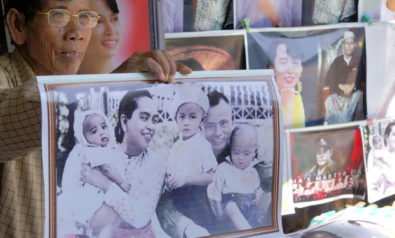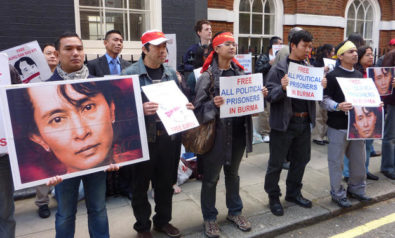The recent violence against the Rohingya minority in Myanmar has brought to the fold the hidden tensions within a society long isolated from the international community. This is part one in a series of two articles.
The two most repeated words in the English Language are “Never Again”, heard in commemorations of the Holocaust to express the commitment that genocide will never again take place. Yet “Never Again” has also come to symbolise the absolute weakness in the will of the international community to act against genocide. This weakness was exposed in Bosnia and in Rwanda and now it seems that it is being exposed yet again, now in Myanmar with its ethnic Rohingya people, a Muslim minority living in the Arakan region.
As reports of mass killings, mass graves, rape, and torture come out of Myanmar with figures of at least 20,000 Rohingya killed since June 28, it seems that like Rwanda and Bosnia, a group of voiceless people are once again being systematically wiped out. This seems to be sanctioned by their government, under the eyes of the international community. The pictures in circulation (although it is hard to verify their authenticity sometimes) depict the horrific nature and scale of the existing tensions in Myanmar.
Many of the Rohingyas have been forced to flee to Bangladesh by boat with some reportedly travelling for days on end to escape the trauma of the current situation. However, they have been refused entry by the Bangladeshi government which has also suspended aid agencies from working in the camps which harbour Rohingya refugees.
Perhaps what is even more shocking is the complicity of the entire country of Myanmar, from the President down to the grass roots. The President has come on record to tell the UN to “establish refugee camps and allow for the deportation of ethnic Rohingya as the ‘only solution’”, whilst Buddhist monks have backed calls for the extermination of the race of Rohingyas. This statewide support for the killing of “Kalaras”, which is the pejorative slur that has become a popular and casual way of referring to Muslims of South Asian decent – or the Rohingyas – is once again reminiscent of Rwanda which witnessed an exhortation for mass killings over the public airwaves.
The flood of nationalist sentiment that has followed these incidents will serve to distract the population from ongoing ethnic conflicts in the north, public anger at rising electricity prices, and industrial workers' strikes in Rangoon, all of which have threatened the government's standing in recent months. There is in fact good reason to suspect that government officials may also have a role in whipping up anti Rohingya sentiments. This has been verified by a Human Rights Watch report, which accused security forces of actively persecuting ethnic Rohingya during the most recent bout of violence. There are some who have also suggested that the timing of the latest cycle of violence is related to the growing acceptance of the country within the international community and the rising prospects for investment. Myanmar has untapped natural resources (which could render the country quite prosperous), yet a fair proportion of this is in areas which are now occupied by the Rohingyas. Hence the pogroms perhaps have an economic incentive as well.
The violence has reached an international level and the United Nations human rights chief Navi Pillay has called for an independent investigation into claims that security forces are systematically targeting the Rohingya. Yet with the banning of Foreign NGOs from the region by the government of Myanmar, and the prohibitions imposed by the government of Bangladesh, the ground realities are unclear. Whilst the Turkish government has led the way in its response to the humanitarian crisis, it seems that there is still some uncertainty in the international community over how best to respond to the humanitarian and human rights crisis unfolding in Myanmar.
The trigger for this violence was the alleged rape of a Buddhist girl by Muslim boys. Though the exact details of what had happened are unclear, what is clear is that the ethnic (and religious tensions) are so high, particularly in the province of Rakhian, that a strong rumour is enough to spark off riots and killings.
Rumours or not, the violence is a symbol of the underlying tensions that run deep in Myanmar and have to do with the fear of "the other"; a fear that has reared its head sporadically in the anti-Chinese and anti-Indian riots of the past century. However, this fear of the “other” has not been as great as the simmering resentment against the Muslims of Myanmar (and in particular against the citizenship of the ethnic Rohingyas who are all Muslims). This resentment is exploited by politicians pandering to nationalist passions and religious prejudice, and has been largely overlooked in black-and-white depictions of the situation.
Resentment Against Muslims
Whilst there are at least a dozen “ethnicities” in Myanmar, the Muslims are particularly diverse. There are very few ethnic Burmese Muslims, with most being migrants from different parts of India from when Burma was a part of India. In addition to their Muslim names, these Muslims also have Burmese names. They are known publically by the latter, and in private in their own communities, by the former. For example, a person may have “Chitko O-O” as his Burmese name and “Mohammad Nasiruddin” as his Islamic name.
Accusations that the government has sought to dilute, or "Burmanise", Myanmar's 135 distinct ethnic groups, in particular the Muslims, have existed for decades. These accusations factor in the apparently institutional practice of rape of ethnic women by Myanmar’s troops, as well as the forced teaching of the Burmese language in ethnic schools. Governments have used the premises "illegal migration management" and "control on population growth" to justify the persecution of this group. However this is not consistent, as millions of Chinese who have migrated to Myanmar in recent decades have become powerful players in the economy.
This hostility towards the often darker skinned Muslim groups in Myanmar (or between Muslims and Buddhists) has its roots in colonial history. The same key issue that fuelled the infamous anti-Chinese riots of the late 1960s and 1970s, being that Myanmarese were aggrieved at jobs going to foreigners, had also driven the anti-Indian and anti-Muslim riots in 1930 and 1938. The post-colonial civilian government in the early 1950s expelled the Burma Muslim Congress and made Buddhism the state religion. This was followed in the 1960s by the mass expulsion of Indians (brought in for work by the British), on the rhetoric of anti-Muslim propaganda, and the latter were branded as colonial stooges. Subsequently, anti-Islamic sentiment was used to ban all Muslims from the army. This propaganda has had lingering effects within the country such that Muslims have been deprived of their basic rights to education and employment and are subjected to forced labour, extortion, and other coercive measures.
The ethnic Rohingyas are currently the ones facing the brunt of the ethnic killings and tension. This happens under the claim that they are illegal immigrants or are Bangladeshi (because of similar cultural and physical characteristics that they share with people from Bangladesh).
However, it is not true that the Rohingyas are illegal immigrants. The ancestors of the Rohingya settled in the Arakan region between the 14th and 18th centuries. Muslim sultans ruled the Arakanese city of Mrauk U, which was in its zenith in the 17th century and a key trading hub in Asia. This was long before the main wave of Indian immigrants arrived in Burma after it was conquered by the British Empire during the 19th century. By the 1930s, the new Indian arrivals were a majority in most big Burmese cities, and dominated the commercial sector of the economy. Modern-era Muslim political participation in the Arakan state itself goes back to the 1930s.
The Japanese invasion of Burma during the Second World War drove out most of those Indian immigrants, but the Burmese fear and hatred of “foreigners” in their midst remained, and it then turned against the Rohingya. They were targeted mainly because they were perceived as “foreigners”, but the fact that they were Muslims in an overwhelmingly Buddhist country made them seem even more alien.
The Rohingya of Arakan were poor farmers, just like their Buddhist neighbours, and their right to Burmese citizenship was unquestioned until the Burmese military seized power in 1962. The army attacked the Rohingya community and drove some 200,000 of them across the border into Bangladesh in 1978, in a campaign marked by widespread killings, mass rape, and the destruction of mosques. Another military campaign drove a further 250,000 Rohingyas into Bangladesh in 1990 and 1991.
The military government of Myanmar refused to recognize them as citizens of Myanmar. The military dictator of the day, Ne Win, revoked the citizenship of all Rohingyas in 1982, thereby justifying their expulsion and ill treatment by labelling them "illegal Bengali immigrants". Other newly enacted laws forbade them several rights. Rohingya babies born out of wedlock were placed on blacklists, and barred from attending school and later marrying; Rohingyas were banned from owning land; a Rohingya couple had to apply well in advance before attempting to wed; and newly married couples had to sign a commitment to have no more than two children.
This animosity is shared by senior figures in the government; the current representative to the United Nations (UN), Ye Myint Aung, once described the Rohingya: "as ugly as ogres".
The Northern Arakan state, where the majority of Rohingyas reside, is now virtually an open prison. Foreigners are barred from entering, and the Rohingyas are subject to a system of travel permits that controls their movements.
The Muslims who have crossed into Bangladesh over the past three decades have been living in some of the worst possible conditions in camps along the border. The unofficial refugee camps have no running water, drainage, or health facilities, leaving the Rohingya Muslims in poverty without any aid or intervention. Such is the treatment of the Rohingya that up to 300,000 now reside in Bangladesh, which in turn sees them as illegal immigrants from Myanmar and denies them citizenship. They are the epitome of “stateless”, and spend their lives in unofficial camps where conditions are notoriously poor (only 28,000 are registered by the UN).
The current crisis with the Rohingyas poses a lot of interesting questions and dilemmas on how Myanmar (and the political stakeholders within it) will engage with the international community in the future.
Read the second part of this article on August 30, 2012.
The views expressed in this article are the author's own and do not necessarily reflect Fair Observer’s editorial policy.
Support Fair Observer
We rely on your support for our independence, diversity and quality.
For more than 10 years, Fair Observer has been free, fair and independent. No billionaire owns us, no advertisers control us. We are a reader-supported nonprofit. Unlike many other publications, we keep our content free for readers regardless of where they live or whether they can afford to pay. We have no paywalls and no ads.
In the post-truth era of fake news, echo chambers and filter bubbles, we publish a plurality of perspectives from around the world. Anyone can publish with us, but everyone goes through a rigorous editorial process. So, you get fact-checked, well-reasoned content instead of noise.
We publish 2,500+ voices from 90+ countries. We also conduct education and training programs
on subjects ranging from digital media and journalism to writing and critical thinking. This
doesn’t come cheap. Servers, editors, trainers and web developers cost
money.
Please consider supporting us on a regular basis as a recurring donor or a
sustaining member.
Will you support FO’s journalism?
We rely on your support for our independence, diversity and quality.

















Comment